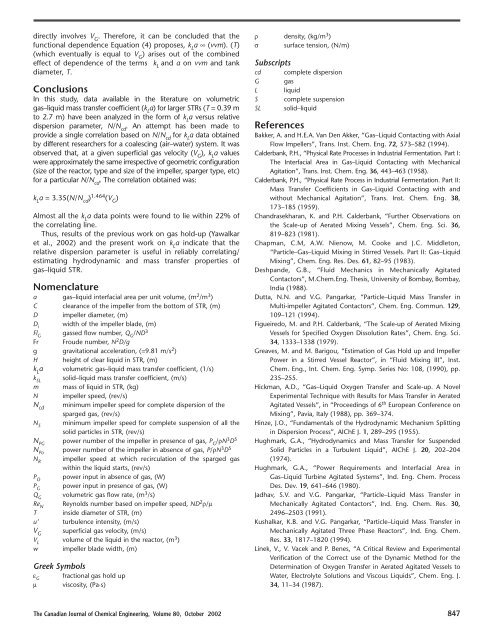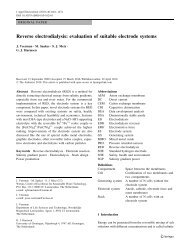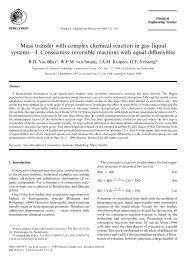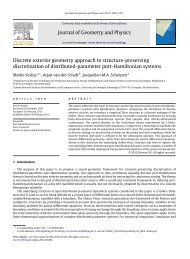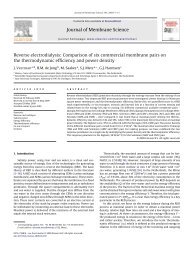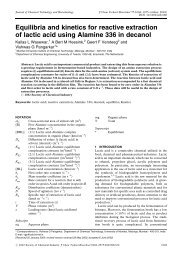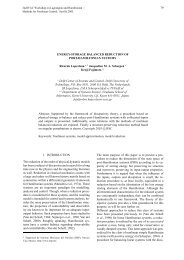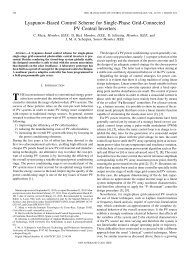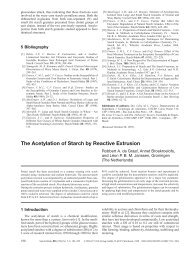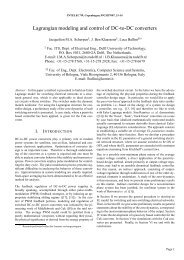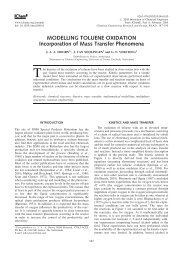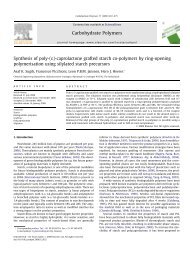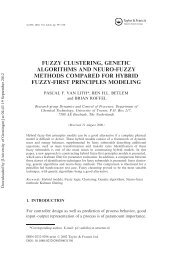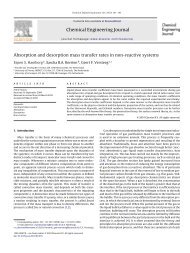Gas-Liquid Mass Transfer Coefficient in Stirred Tank Reactors - ITM
Gas-Liquid Mass Transfer Coefficient in Stirred Tank Reactors - ITM
Gas-Liquid Mass Transfer Coefficient in Stirred Tank Reactors - ITM
Create successful ePaper yourself
Turn your PDF publications into a flip-book with our unique Google optimized e-Paper software.
directly <strong>in</strong>volves V G . Therefore, it can be concluded that the<br />
functional dependence Equation (4) proposes, k L a • (vvm). (T)<br />
(which eventually is equal to V G ) arises out of the comb<strong>in</strong>ed<br />
effect of dependence of the terms k L and a on vvm and tank<br />
diameter, T.<br />
Conclusions<br />
In this study, data available <strong>in</strong> the literature on volumetric<br />
gas–liquid mass transfer coefficient (k L a) for larger STRs (T = 0.39 m<br />
to 2.7 m) have been analyzed <strong>in</strong> the form of k L a versus relative<br />
dispersion parameter, N/N cd . An attempt has been made to<br />
provide a s<strong>in</strong>gle correlation based on N/N cd for k L a data obta<strong>in</strong>ed<br />
by different researchers for a coalesc<strong>in</strong>g (air–water) system. It was<br />
observed that, at a given superficial gas velocity (V G ), k L a values<br />
were approximately the same irrespective of geometric configuration<br />
(size of the reactor, type and size of the impeller, sparger type, etc)<br />
for a particular N/N cd . The correlation obta<strong>in</strong>ed was:<br />
k L a = 3.35(N/N cd ) 1.464 (V G )<br />
Almost all the k L a data po<strong>in</strong>ts were found to lie with<strong>in</strong> 22% of<br />
the correlat<strong>in</strong>g l<strong>in</strong>e.<br />
Thus, results of the previous work on gas hold-up (Yawalkar<br />
et al., 2002) and the present work on k L a <strong>in</strong>dicate that the<br />
relative dispersion parameter is useful <strong>in</strong> reliably correlat<strong>in</strong>g/<br />
estimat<strong>in</strong>g hydrodynamic and mass transfer properties of<br />
gas–liquid STR.<br />
Nomenclature<br />
a gas–liquid <strong>in</strong>terfacial area per unit volume, (m2 /m3 )<br />
C clearance of the impeller from the bottom of STR, (m)<br />
D impeller diameter, (m)<br />
Di width of the impeller blade, (m)<br />
FlG gassed flow number, QG /ND3 Fr Froude number, N2D/g g gravitational acceleration, (=9.81 m/s2 )<br />
H height of clear liquid <strong>in</strong> STR, (m)<br />
kLa volumetric gas–liquid mass transfer coefficient, (1/s)<br />
kSL solid–liquid mass transfer coefficient, (m/s)<br />
m mass of liquid <strong>in</strong> STR, (kg)<br />
N impeller speed, (rev/s)<br />
Ncd m<strong>in</strong>imum impeller speed for complete dispersion of the<br />
sparged gas, (rev/s)<br />
NS m<strong>in</strong>imum impeller speed for complete suspension of all the<br />
solid particles <strong>in</strong> STR, (rev/s)<br />
NPG power number of the impeller <strong>in</strong> presence of gas, PG /rN3D5 NPo power number of the impeller <strong>in</strong> absence of gas, P/rN3D5 NR impeller speed at which recirculation of the sparged gas<br />
with<strong>in</strong> the liquid starts, (rev/s)<br />
PO power <strong>in</strong>put <strong>in</strong> absence of gas, (W)<br />
PG power <strong>in</strong>put <strong>in</strong> presence of gas, (W)<br />
QG volumetric gas flow rate, (m3 /s)<br />
ReN Reynolds number based on impeller speed, ND2r/m T <strong>in</strong>side diameter of STR, (m)<br />
u’ turbulence <strong>in</strong>tensity, (m/s)<br />
VG superficial gas velocity, (m/s)<br />
VL volume of the liquid <strong>in</strong> the reactor, (m3 )<br />
w impeller blade width, (m)<br />
Greek Symbols<br />
eG fractional gas hold up<br />
m viscosity, (Pa·s)<br />
r density, (kg/m 3 )<br />
s surface tension, (N/m)<br />
Subscripts<br />
cd complete dispersion<br />
G gas<br />
L liquid<br />
S complete suspension<br />
SL solid–liquid<br />
References<br />
Bakker, A. and H.E.A. Van Den Akker, “<strong>Gas</strong>–<strong>Liquid</strong> Contact<strong>in</strong>g with Axial<br />
Flow Impellers”, Trans. Inst. Chem. Eng. 72, 573–582 (1994).<br />
Calderbank, P.H., “Physical Rate Processes <strong>in</strong> Industrial Fermentation. Part I:<br />
The Interfacial Area <strong>in</strong> <strong>Gas</strong>–<strong>Liquid</strong> Contact<strong>in</strong>g with Mechanical<br />
Agitation”, Trans. Inst. Chem. Eng. 36, 443–463 (1958).<br />
Calderbank, P.H., “Physical Rate Process <strong>in</strong> Industrial Fermentation. Part II:<br />
<strong>Mass</strong> <strong>Transfer</strong> <strong>Coefficient</strong>s <strong>in</strong> <strong>Gas</strong>–<strong>Liquid</strong> Contact<strong>in</strong>g with and<br />
without Mechanical Agitation”, Trans. Inst. Chem. Eng. 38,<br />
173–185 (1959).<br />
Chandrasekharan, K. and P.H. Calderbank, “Further Observations on<br />
the Scale-up of Aerated Mix<strong>in</strong>g Vessels”, Chem. Eng. Sci. 36,<br />
819–823 (1981).<br />
Chapman, C.M, A.W. Nienow, M. Cooke and J.C. Middleton,<br />
“Particle–<strong>Gas</strong>–<strong>Liquid</strong> Mix<strong>in</strong>g <strong>in</strong> <strong>Stirred</strong> Vessels. Part II: <strong>Gas</strong>–<strong>Liquid</strong><br />
Mix<strong>in</strong>g”, Chem. Eng. Res. Des. 61, 82–95 (1983).<br />
Deshpande, G.B., “Fluid Mechanics <strong>in</strong> Mechanically Agitated<br />
Contactors”, M.Chem.Eng. Thesis, University of Bombay, Bombay,<br />
India (1988).<br />
Dutta, N.N. and V.G. Pangarkar, “Particle–<strong>Liquid</strong> <strong>Mass</strong> <strong>Transfer</strong> <strong>in</strong><br />
Multi-impeller Agitated Contactors”, Chem. Eng. Commun. 129,<br />
109–121 (1994).<br />
Figueiredo, M. and P.H. Calderbank, “The Scale-up of Aerated Mix<strong>in</strong>g<br />
Vessels for Specified Oxygen Dissolution Rates”, Chem. Eng. Sci.<br />
34, 1333–1338 (1979).<br />
Greaves, M. and M. Barigou, “Estimation of <strong>Gas</strong> Hold up and Impeller<br />
Power <strong>in</strong> a <strong>Stirred</strong> Vessel Reactor”, <strong>in</strong> “Fluid Mix<strong>in</strong>g III”, Inst.<br />
Chem. Eng., Int. Chem. Eng. Symp. Series No: 108, (1990), pp.<br />
235–255.<br />
Hickman, A.D., “<strong>Gas</strong>–<strong>Liquid</strong> Oxygen <strong>Transfer</strong> and Scale-up. A Novel<br />
Experimental Technique with Results for <strong>Mass</strong> <strong>Transfer</strong> <strong>in</strong> Aerated<br />
Agitated Vessels”, <strong>in</strong> “Proceed<strong>in</strong>gs of 6 th European Conference on<br />
Mix<strong>in</strong>g”, Pavia, Italy (1988), pp. 369–374.<br />
H<strong>in</strong>ze, J.O., “Fundamentals of the Hydrodynamic Mechanism Splitt<strong>in</strong>g<br />
<strong>in</strong> Dispersion Process”, AIChE J. 1, 289–295 (1955).<br />
Hughmark, G.A., “Hydrodynamics and <strong>Mass</strong> <strong>Transfer</strong> for Suspended<br />
Solid Particles <strong>in</strong> a Turbulent <strong>Liquid</strong>”, AIChE J. 20, 202–204<br />
(1974).<br />
Hughmark, G.A., “Power Requirements and Interfacial Area <strong>in</strong><br />
<strong>Gas</strong>–<strong>Liquid</strong> Turb<strong>in</strong>e Agitated Systems”, Ind. Eng. Chem. Process<br />
Des. Dev. 19, 641–646 (1980).<br />
Jadhav, S.V. and V.G. Pangarkar, “Particle–<strong>Liquid</strong> <strong>Mass</strong> <strong>Transfer</strong> <strong>in</strong><br />
Mechanically Agitated Contactors”, Ind. Eng. Chem. Res. 30,<br />
2496–2503 (1991).<br />
Kushalkar, K.B. and V.G. Pangarkar, “Particle–<strong>Liquid</strong> <strong>Mass</strong> <strong>Transfer</strong> <strong>in</strong><br />
Mechanically Agitated Three Phase <strong>Reactors</strong>”, Ind. Eng. Chem.<br />
Res. 33, 1817–1820 (1994).<br />
L<strong>in</strong>ek, V., V. Vacek and P. Benes, “A Critical Review and Experimental<br />
Verification of the Correct use of the Dynamic Method for the<br />
Determ<strong>in</strong>ation of Oxygen <strong>Transfer</strong> <strong>in</strong> Aerated Agitated Vessels to<br />
Water, Electrolyte Solutions and Viscous <strong>Liquid</strong>s”, Chem. Eng. J.<br />
34, 11–34 (1987).<br />
The Canadian Journal of Chemical Eng<strong>in</strong>eer<strong>in</strong>g, Volume 80, October 2002 847


